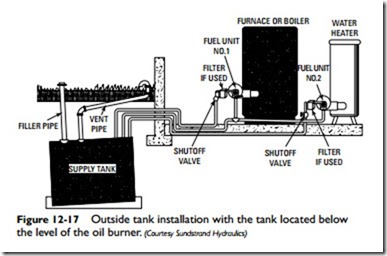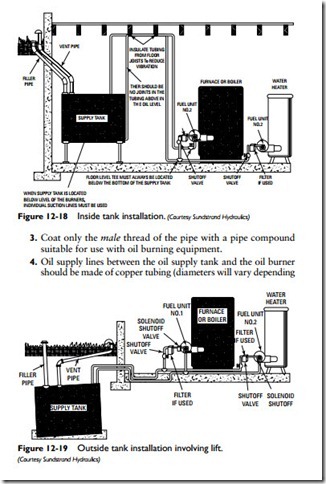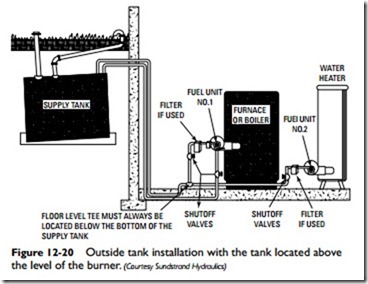Fuel Supply Tank and Fuel Line
The fuel oil for an oil furnace is stored in a fuel supply tank. The tank is commonly connected directly to the fuel pump in the burner assembly of the furnace.
The fuel supply tank and fuel line must be installed in accordance with the requirements of UL and any local codes and regulations. Local codes and ordinances take precedence over national standards.
Note
Although an existing tank probably has already met the requirements of the local codes and regulations, it would be prudent to check just to make certain. This is especially true of older, buried fuel supply tanks, because they occasionally leak. A leaking fuel supply tank violates the environmental laws in many areas of the country.
Additional information about fuel supply tanks can be obtained from Installation of Burning Equipment 1972 (NFPA No. 31), a publication of the National Fire Protection Association (NFPA). Use only an approved tank and line for the installation.
A one-pipe system is recommended for an oil-tank installation when the following conditions are present:
1. Tank is installed in the basement or similar location and/or below the pump inlet port.
2. Vacuum at pump does not exceed 2 in.
A two-pipe (return line) system is recommended for a tank installation when the following conditions exist:
1. Tank is located outside and/or below the oil-pump inlet port.
2. Vacuum at pump does not exceed 10 in.
Use a two-stage pump for installations having especially long lines or high lifts if the vacuum at the inlet port does not exceed 20 in.
A shutoff valve should be installed in the suction line close to the oil burner. This valve enables the operator to disconnect the line without draining it. Do not place a shutoff valve in the return line.
Closing a shutoff valve on the return line while the oil burner is operating could damage the pump. All joints in the fuel line should be sealed with a suitable oil-piping compound.
Note
A leak in the oil line will cause a loss of pump prime and a failure of the burner to light within the required 15 seconds of the ignition cycle.
Fuel Tank Location
The location of the oil supply tank is subject to local regulations.
These must be consulted before a new tank is installed.
The supply tank can be located inside or outside the building, above the level of the oil burner or below it. Furthermore, outside tanks can be located underground or above it. It is recommended that larger supply tanks be located outside and underground.
Figures 12-17 through 12-20 illustrate four ways to locate oil supply tanks. When installing a fuel tank, the following suggestions should prove helpful:
1. The filler pipe should be a minimum of 2 inches in diameter; the vent pipe 11⁄4 inches.
2. Use wrought-iron pipe with malleable-iron fittings for both the filler and vent pipes.
on local regulations, pipe length, and the specifications of the oil burner being used).
5. Use a floor-level tee if the oil supply lines run overhead.
6. The oil burners for the water heater and furnace (or boiler) may be connected to a common feed line in conventional gravity feed installations (Figure 12-20).
7. No return line is necessary when the supply tank is installed above the level of the oil burner and the oil is fed by gravity to the burner.
8. Use a single-line system if the oil is gravity fed from the supply tank to the burner.
9. Use a two-line system if the oil tank is buried and below the level of the burner.
Related posts:
Incoming search terms:
- Machinery Fuel Supply mail
- JP54 JETA1 D6 D2 FUEL OIL GAS OIL TANK FRAM OIL AND GAS STORAGE COMPANY mail
- home heating oil fuel lines
- fuel oil tank supply line
- Oil Line Tubing from tank to furnace
- assembly line furnace
- oil furnace pump inlet
- bleeding a beckett furnace fuel line 8 feet above tank
- looking for fuel tank filter for furnance
- how to run fuel lines for a residential boiler
- best fuel pipe for oil furnace
- can you run residential fuel line over head
- Fuel oil tank is a pump need fro oil tank to heater
- how many valves on a fuel line on Oil Furnace
- what is standard size of a furnace residential tank
- house oil tank blow line
- one line oil burner furanc
- running oil lines from tank to oil furnace
- can a return line be used on a residential outside oil tank
- home heating oil fuel lines connectors
- Building Material Machinery mail
- putting oil in the vent line on hlme fuel oil tank
- how to copper tubing and oil filter assy to oil burner
- oil furnace line size
- fuel tank for fuel oil furnace
- how to hook up gavity oil stove
- how do you install a return fuel fitting to a polyurthane tank
- where to place oil feed line filter on oil fired boiler
- 20 In a(n) ____________________ fuel oil supply system one pipe is the supply and the other acts as the return
- furnace oil line tubing
- how to install supply lines on uprite oil tank
- oil stove fuel line
- Is fuel outlet pipe the top line or bottom line?
- copper fule line for oil furnace
- The fuel line coming from the oil tank is recommended to have a filter in the line to catch small particles and dirt
- diagram fuel oil supply to furnace
- fuel leakattopoftankdripisdarksmellsgasanoil?
- copper oil supply line for oil furnace
- supply line on home furnace
- furnice oil line
- oil furnace oil line installation
- how big a size fuel line needs to be running to a burner
- WHAT CAN I USE TO CARRY FUEL OIL TO MY FURNACE
- Special furnace mail
- running oil from outside tank for used oil heater
- how to plumb a top feed oil tank
- flexible fuel line for kerosene tank
- oil tank lines
- how to hook up second line to oil pump on furnance
- how to set oil furnace for 2 supply lines


